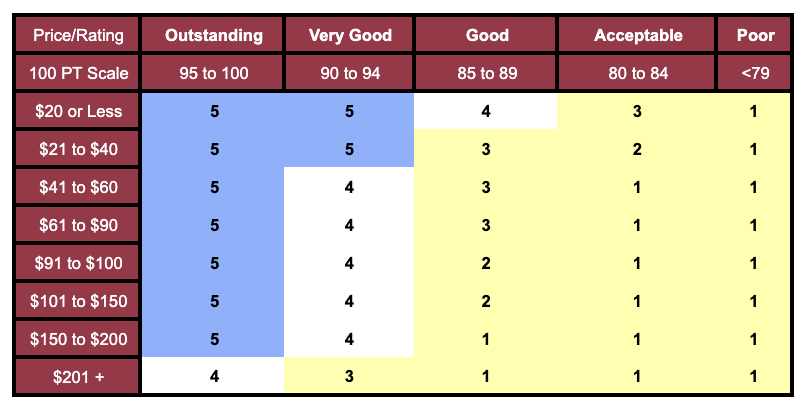
The scale is simple. If you are paying a lot for your wine, you need to expect the best.
So, If you have ever wondered how we arrive at our Value Scale, well, here it is in Black and White. (And Blue, Red, and Yellow.)
- Blue – Excellent Value – Buy it.
- White – Good Value – But the lower the price, the better.
- Yellow – Pass – It may be an Outstanding, Very Good, or Good wine, but not worth the price.
*For those of you that are used to the 100 point system, the reference at the top corresponds to the wines rating.
How We Determine a Wines Rating
At times, you may encounter a wine that doesn’t align with your personal preference, but does that make it a subpar wine? Or is it merely not your cup of tea, so to speak?
This is where the BLIC comes into play.
We often have to make impartial judgments about wines that might not be our first pick. The BLIC test offers an efficient, straightforward method for assessing a wine’s quality.
To put it simply, a substandard wine will possess one or none of the following characteristics, an average one will exhibit two, a good wine will display three, and an outstanding wine will encompass all four. You may also award half points and sum them up for a total score. (And decide a wine is very good.)
B – Balance
Does everything (acidity, alcohol, flavors, sugars, and so on) function in a harmonious way? Is there any element that overwhelms others, like an overpowering sour acidity or a strong alcohol burn?
L – Length
Once the wine is swallowed (or spat out), how long do the flavors persist on your palate? This isn’t about the heat of the alcohol – it’s about the actual flavors of the wine. Generally, the longer the flavors linger on the finish, the higher the wine’s quality.
I – Intensity / Identity
Technically, this refers to “Intensity,” but I feel this can be misleading and somewhat unjust to more delicate wines. Hence, I prefer to refer to this as “Intensity / Identity.” Are you able to distinguish the prominent aromas and flavors of the wine?
C – Complexity
Following on from the previous point, if you can only discern about three aromas and flavors, it might be classified as a “simple” wine. While this doesn’t necessarily denote a bad wine – some wines are intended to be uncomplicated and easily drinkable – more outstanding wines tend to exhibit complexity, featuring layers of flavors that reflect the care and time invested in their creation. These can be primary (the flavors of the grape itself), secondary (the flavors resulting from the winemaker’s decisions during the winemaking process), or tertiary (the evolving flavors of a wine as it ages).
In conclusion, disliking a wine doesn’t automatically label it as “bad” – after all, one man’s meat is another man’s poison. Training your palate to distinguish not just good wine, but also the wine you personally enjoy, ultimately comes down to practice!


